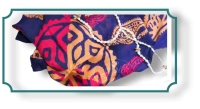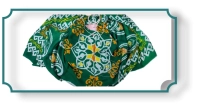Dear buyers!
Let’s review the order of distinguishing a real kelagayi from a false one.
I’ll describe in consequence.
A real kelagayi is made of 100% silk, a big kelagayi (160х160 cm) easily passes through an engagement ring (for instance, last winter we took a spontaneous video with the manager of hotel in Gabala, the kerchief was occasionally taken from the stock i.e. nothing was planned):
{dd_yt_video}videoid:KhlIl8vZmrs:width:640:height:460{/dd}
then, a silk thread from a kelagayi burns completely without leaving synthetic balls like 100% wool. Touching, a kelagayi is very tender, pleasant and warm. If you feel coolness from the fabric and it shines like a satin or, the kerchief has a lot of bright and motley colors and the figure is very small (the kelagayi-making technology does not allow work with very small galibs) it means that it is unreal kelagayi. Besides, the price may prove it – a real kelagayi cannot be cheap (AZN 10-20).
Another moment is dimensions:
- a real kelagayi has standard sizes: 240х240 (presently they almost are not manufactured), 160х160 (mainly, made in Basgal), 150х150 (made in Sheki);
- scarves’ sizes are 160х80, 160х40 (made in Basgal), 185х65 (made in Sheki);
- dinga kerchiefs’ sizes are 80х80 (made in Basgal) and probably 75х75 (made in Sheki).
Possible declination in dimensions is ± 3-7 cm.
Furthermore, all craftsmen use own marking on own kelagayies, scarves or dinga kerchiefs.
Presently, there are 4 kelagayi-making points in Azerbaijan and we cooperate with 2 of them. Two points work in Basgal and 2 ones in Sheki.
In consequence:
1) The Sheki Silk Factory marks own kelagayies and dinga kerchiefs with stamp «Şəki Silk 100%»; usually, it is a white stamp on the kelagayi’s corner. They do not mark the scarves.
2) Basgal Silk Center is a museum and workshop in museum or, on the contrary, a museum in workshop. But the essence is not important – we are not aware of their marking but think that it exists. We distinguish their works upon inaccuracy of processing the kelagayi’s corners with pattern.
3) There is a craftsman in Sheki and his kerchiefs also have own marking – he mostly signs as “Ziya”, “Ziya Məmmədov”, "Z.M.”, but sometimes he also has not marking and we determine the craftsman upon the pattern.
4) There is a craftsman also in Basgal and his marking is the letter «B» in buta or simply, the letter «B» usually on the corner. His kelagayies often have marking (with rear exclusions) but the scarves and kerchiefs sometimes have not.
However, touching kelagayi we feel like paper subsequently to washing – sometimes they get starched; but further upon wearing and washing kelagayi becomes softer and tender.
As regards the quality certificates and other patents, presently the craftsman from Basgal is in the process of acquiring a certificate and we also waiting for it. The Sheki factory has neither certificates nor patents. We have no information regarding existence of appropriate documents of the remaining manufacturers because we do not work with them.
Besides, just believe – if you have kept a kelagayi in your hand any time you will not confuse its quality! Kelagayi is a tender and thin silk pleasant for skin and keeping warmness.
The photo has samples of marking of the craftsman from Basgal and the Sheki factory (the last factory). Later I’ll try to insert the Ziya’s marking in the comment – certainly, if you are interested.
It is also noticeable that the edges of kelagayi are not subject to processing
Presently there is a boutique having a photo expressing the package of a famous brand saling kelaghayi. However, the kerchieves offered by this boutique are not original kelaghayi:
1.Their edges are processed whereas the edges of original kelaghayi are not subject to processing;
- The material looks like satin and has evidently expressed sparkling;
3.The figures on this material is printed but not made manually and, they remind the Sheki ones;
- These kerchieves have inscription «KALAĞAYI» but it is inadmittable because it is not clear whether it is in Azerbaijani or English language. It should be either KƏLAĞAYI or KELAGHAYI;
- The price involving most of customers is lower twice that that of original kelaghayi.
Certainly, everibody is entitled to acquire them but it should be remembered that they are not original kelaghayi but a cheap kerchief in kelaghayi style of non-manual production.
[yjsgimgs image="images/logotipi/1.jpg" class="bspace yjsg-lightbox" title="1" link="images/logotipi/1.jpg" target="" effect="none"][yjsgimgs image="images/logotipi/2.jpg" class="bspace yjsg-lightbox" title="2" link="images/logotipi/2.jpg" target="" effect="none"][yjsgimgs image="images/logotipi/3_ziya.jpg" class="bspace yjsg-lightbox" title="3" link="images/logotipi/3_ziya.jpg" target="" effect="nonr"][yjsgimgs image="images/logotipi/4.jpg" class="bspace yjsg-lightbox" title="4" link="images/logotipi/4.jpg" target="" effect="none"][yjsgimgs image="images/logotipi/5.jpg" class="bspace yjsg-lightbox" title="5" link="images/logotipi/5.jpg" target="" effect="none"][yjsgimgs image="images/logotipi/6.jpeg" class="bspace yjsg-lightbox" title="6" link="images/logotipi/6.jpeg" target="" effect="none"]







